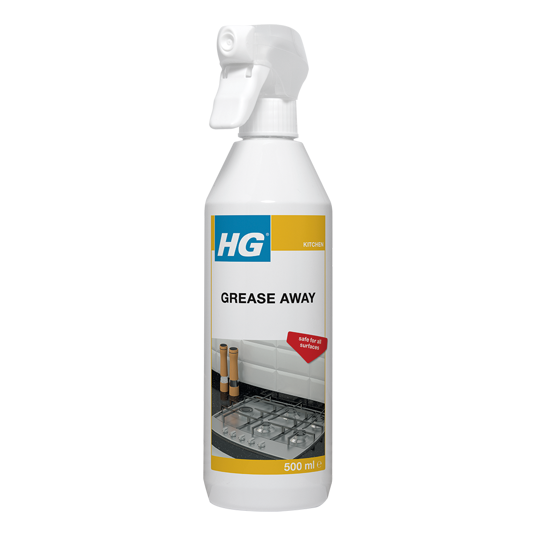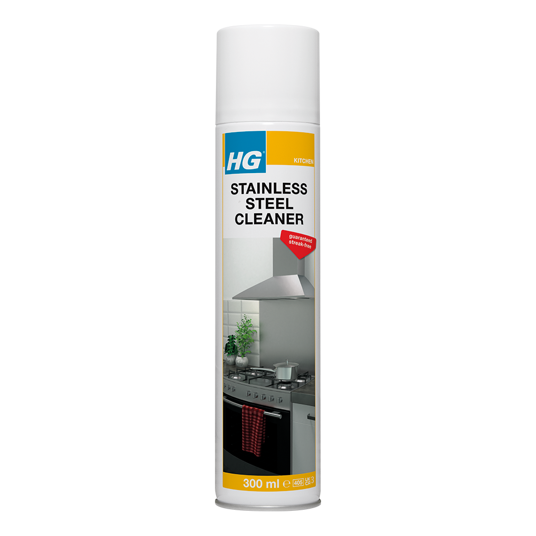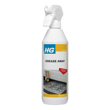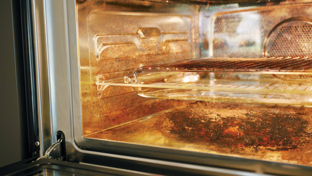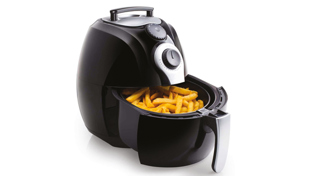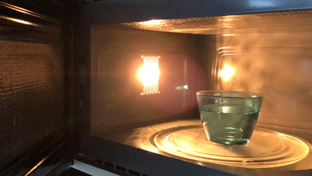HG is the quick option for cleaning gas hob burners
HG has everything you need for cleaning your cooker. Whether it is an enamel, aluminium, ceramic or stainless steel cooker. HG grease away is the quick and easy way to remove oil and grease. It is also ideal for all the parts. Cleaning a cast-iron pan support takes no time with HG grease away, and the same applies to cleaning the burners of the stove. Apart from using HG grease away, you can also clean an aluminium or stainless steel gas cooker with HG stainless-steel cleaner.
This is how you use HG grease away to clean the stove top, burners and cast-iron pan supports:
- Spray HG grease away on the stove and leave it to absorb for a few seconds.
- For stainless steel, you need to spray the product on a clean cloth first. Then use the cloth to clean the stainless steel gas cooker.
- Wipe off the grease with a cloth immersed in warm water.
- Repeat the treatment for stubborn dirt.
How to clean your stove with 3 tips
HG grease away is the quickest way to clean the gas cooker, but there are alternative methods. They only work for cleaning the stove. Further down you can read how to clean stove burners and pan supports. We cannot guarantee that they work. Be particularly careful when you clean a stainless steel gas stove. Stainless steel can damage quickly if you use the wrong products.
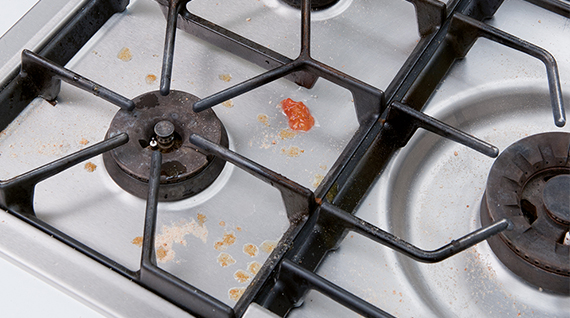 1.Cleaning a gas stove with washing-up liquid
1.Cleaning a gas stove with washing-up liquid
You can clean a cooker with hot water and washing-up liquid. Washing-up liquid often has a mildly degreasing effect, ensuring it removes grease.
2. Cleaning a gas cooker with flour and vinegar
You need to be careful, particularly when you clean a stainless steel gas stove. For stainless steel, a mixture of flour and cleaning vinegar may be the answer, as it does not damage the stainless steel. Rub the mixture on the stove and wipe it off with a cloth and water after a few minutes.
3. Cleaning a gas cooker with soda and vinegar
Around the gas burners is a good place to clean with soda. Sprinkle some soda on the brown stains. Add a little vinegar. Now clean the stove with a non-scratch scouring sponge. If your stove is made of aluminium, absolutely do not use baking soda. It makes aluminium dull.
How to clean a gas burner with 4 alternative products
Gas burners often consist of two types of materials: stainless steel or aluminium and cast iron. The products below can be used for both materials when you clean the gas burners. Remember, you do use them at your own risk.
1. Cleaning gas burners with vinegar
You can clean gas burners with vinegar. Add some cleaning vinegar to a container of hot water. Leave the burners to soak in the container for 30 minutes. Then clean them with a scouring sponge. After that, rinse them off and dry them with a cloth.
2. Cleaning gas burners with washing-up liquid
Washing-up liquid also degreases, making it very suitable for cleaning gas burners. Mix some water and washing-up liquid in a bucket. Leave the burners to soak for 30 minutes and brush them clean with a scouring sponge.
3. How to clean gas stove burners with ammonia
You can also clean gas burners with ammonia. We recommend that you only use ammonia on burnt-on burners. Ammonia has a strong smell and is an aggressive product. It is better to use it outside and to wear gloves. Put some ammonia in a dish and put the burners in the dish. Put the dish in a bag and close the bag. Leave it to absorb overnight and remove the burners from the bag the next day. Then clean them properly with a scouring sponge.
4. Cleaning gas burners with cola
Cola can also help to clean gas burners. Put some cola in a dish, put the gas burners in the dish and leave them for 30 minutes. After that, you only need to clean the burners with a sponge.
How to clean cast-iron stove grates with 3 convenient tips
Pan supports are often made of cast iron. Because they are large and because they have difficult corners, it can be tricky to get them clean. You can clean your pan supports with the above tips.
1. How to clean stove burner grates with baking soda
First wash up the pan supports. Mix some water and baking soda. Brush this on the pan supports. Leave this for one hour. Now clean the pan supports with a sponge, but do not use a scouring sponge.
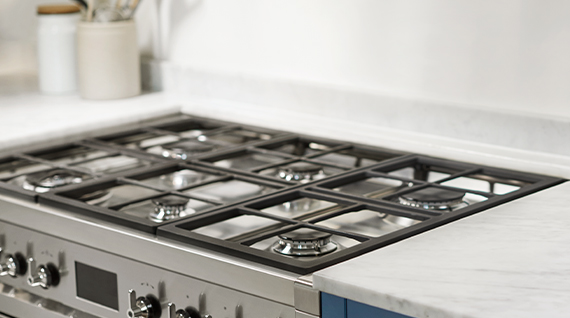 2. Cleaning pan supports with vinegar
2. Cleaning pan supports with vinegar
Vinegar also works to clean pan supports. Vinegar does not work if they are very dirty. So, only use it when the pan supports are not too dirty. Put one part vinegar and one part water in a plant spray. Spray the mixture on the pan supports and leave it to absorb for at least 15 minutes. Then you can clean the pan supports with a sponge and rinse them off.
3. Cleaning pan supports with ammonia
You can also clean pan supports with ammonia. Preferably only when they are really dirty, as ammonia is an aggressive product that should be used with caution. Put the pan supports in a large closable bag. For example a strong rubbish bag. Add no more than 500 ml of ammonia. If you put one grate in a bag, you need just 50 ml per support. Close the bag and leave it at least 3 hours. Or even overnight. Remove the pan supports from the bag and rinse them thoroughly under warm water.
What is best to avoid for cleaning a gas cooker
The most important problem when you clean a gas stove is that you often have to deal with different materials. Some of the frequently recommended products work on cast iron, but not on stainless steel or aluminium. A few examples.
- Do not clean burners with baking soda
Aluminium is not resistant to baking soda. It makes it dull. The rings of the burners are often made of aluminium. You can use soda to clean the cast-iron parts of the burners. Like the cast-iron pan supports. If your entire stove is made of aluminium, don’t use baking soda at all.
- Put parts of the stove in the dishwasher
Opinions are divided on whether you can put cast iron in the dishwasher. Some recommend it, but cast iron may become white in the dishwasher. So, be careful! It is generally not recommended to put the parts of the burners in the dishwasher. We recommend you always check the instructions.
Action plan for cleaning a stove top
A gas stove consists of various parts. Below is a convenient action plan for cleaning your entire gas cooker.
1. Clean the pan supports
Start with the pan supports. Clean them with HG grease away or use an alternative tip.
2. Clean the gas burners
Then clean the gas burners. This can also be done with HG grease away or an alternative product. Be careful with what you do! If you want to clean burners with baking soda, make sure you only use it on the cast-iron parts. Never clean aluminium with baking soda.
3. Clean the stove top
Now you can clean the stove top. Use HG grease away or HG stainless-steel cleaner if you're dealing with stainless steel.
4. Put the parts back
Then you put the parts back. Your stove is sparkling clean again.
If you have a good tip for cleaning a gas cooker, please let us know!
Frequently Asked Questions about cleaning a gas cooker
How do I clean a gas stove?
You can clean a cooker with:
- Washing-up liquid
- Flour and vinegar
- Soda and vinegar, but don't use that on aluminium
How do I clean the burners?
You can clean the burners with:
- Vinegar
- Washing-up liquid
- Ammonia
- Cola
How do I clean the pan supports?
You can clean the pan supports with:
- Baking soda
- Vinegar
- Ammonia
What is best to avoid for cleaning a gas cooker?
The tricky bit about a stove is that it is often made of different materials. They are not always resistant to the same products. So sometimes it's better to avoid baking soda. Parts made of aluminium are not resistant to that. There are also different opinions on whether you should put parts in the dishwasher. We do not recommend this, unless the manufacturer explicitly does.
Which steps do I use to clean the cooker?
Use the following steps to clean your cooker:
- Start by cleaning the pan supports.
- Then clean the gas burners,
- followed by the stove top.
- Now put all the parts back.
Which HG product do I use for cleaning my stove top?
With HG grease away it is easy to remove grease from your cooker.

